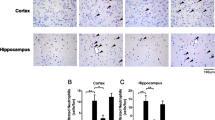Abstract
Assessment of complement 4 (C4) levels in experimental animals is used as a marker for activation of the classical complement pathway. The objective of this study was to develop a method for measuring C4 concentrations in the rat brain. An ELISA (sensitivity = 0.5 ng C4/ml) was used to measure C4 in regional brain homogenates from Fischer rats cardiac-perfused with phosphate buffered saline to remove cerebrovascular contents, and from sham-perfused rats. Ventral midbrain C4 levels were increased (p < 0.001) versus frontal cortex and striatum in sham-perfused rats, whereas after perfusion there were no differences between brain regions. Removal of cerebrovascular contents decreased C4 by 43% in striatum, 52% in frontal cortex, and 69% in ventral midbrain (all p < 0.01 versus sham-perfused means). These results indicate that C4 in the rat brain can be measured quantitatively by ELISA provided that cerebrovascular proteins are removed by perfusion.


Similar content being viewed by others
References
Morgan BP, Harris CL (2003) Complement therapeutics; history and current progress. Mol Immunol 40:159–170
Kirschfink M (2001) Targeting complement in therapy. Immunol Rev 180:177–189
D’Ambrosio AL, Pinsky DJ, Connolly ES (2001) The role of the complement cascade in ischemia/reperfusion injury: implications for neuroprotection. Mol Med 7:367–382
McGeer PL, Akiyama H, Itagaki S, (1989) Activation of the classical complement pathway in brain tissue of Alzheimer patients. Neurosci Lett 107:341–346
Yamada T, McGeer PL, McGeer EG (1992) Lewy bodies in Parkinson’s disease are recognized by antibodies to complement proteins. Acta Neuropathol (Berl) 84:100–104
Yamada T, Moroo I, Koguchi Y et al (1994) Increased concentration of C4d complement protein in the cerebrospinal fluids in progressive supranuclear palsy. Acta Neurol Scand 89:42–46
Matsuoka Y, Picciano M, Malester B et al (2001) Inflammatory responses to amyloidosis in a transgenic mouse model of Alzheimer’s disease. Am J Pathol 158:1345–1354
Sinigaglia-Coimbra R, Cavalheiro EA, Coimbra CG (2002) Postischemic hyperthermia induces Alzheimer-like pathology in the rat brain. Acta Neuropathol (Berl) 103:444–452
Fonseca MI, Zhou J, Botto M et al (2004) Absence of C1q leads to less neuropathology in transgenic mouse models of Alzheimer’s disease. J Neurosci 24:6457–6465
Spielman L, Winger D, Ho L et al (2002) Induction of the complement component C1qB in brain of transgenic mice with neuronal overexpression of human cyclooxygenase-2. Acta Neuropathol (Berl) 103:157–162
Cowell RM, Plane JM, Silverstein FS (2003) Complement activation contributes to hypoxic–ischemic brain injury in neonatal rats. J Neurosci 23:9459–9468
Loeffler DA, Linder MC, Zamany M et al (1999) Measurement of acute phase proteins in the rat brain: contribution of vascular contents. Neurochem Res 24:1313–1317
Bos IG, van Mierlo GJ, Bleeker WK et al (2001) The potentiation of human C1-inhibitor by dextran sulphate is transient in vivo: studies in a rat model. Int Immunopharmacol 1:1583–1595
Roos A, Nauta AJ, Broers D et al (2001) Specific inhibition of the classical complement pathway by C1q-binding peptides. J Immunol 167:7052–7059
Acknowledgments
Thanks are expressed to Donna Selenich, Elizabeth Debeliso, Diane Farrah, and Stephanie Conant, Ph.D., for technical assistance. This investigation was funded by a contribution from Mrs. Martha Loeffler in memory of Drs. Erwin and Harold Loeffler.
Author information
Authors and Affiliations
Corresponding author
Rights and permissions
About this article
Cite this article
Loeffler, D.A., Camp, D.M. Measurement by ELISA of Complement Factor 4 (C4) in the Rat Brain: Necessity for Removal of Cerebrovascular Proteins . Neurochem Res 31, 999–1002 (2006). https://doi.org/10.1007/s11064-006-9105-z
Accepted:
Published:
Issue Date:
DOI: https://doi.org/10.1007/s11064-006-9105-z




